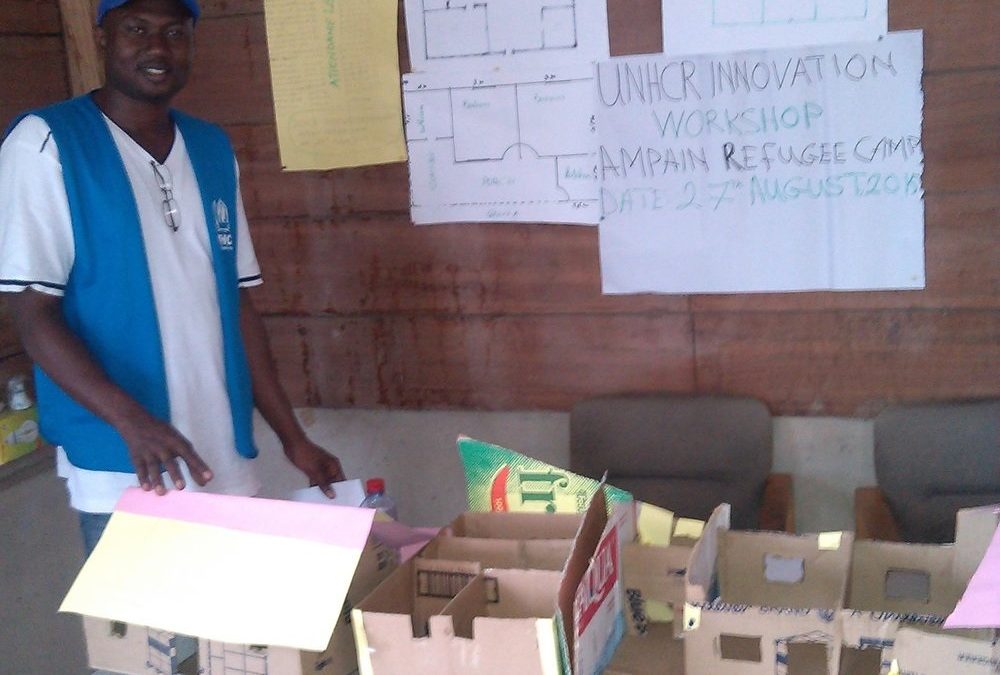Yusif Sidik’s vision of an efficient shelter program involves no sophisticated design, innovative material, or complex logistics. It’s about putting refugees in charge of the process, using locally-sourced materials.
Sidik is a Senior Field Assistant in Ghana, working at the UNHCR Field Office of the Takoradi (FOTAK) duty station. FOTAK provides assistance to three refugee camps, including Ampain, a small refugee camp located in the western region of Ghana. Ampain camp hosts about 5000 persons of concern who left Ivory Coast during the unrest that followed the 2010 elections. While little is told about this crisis in mainstream media, the challenges faced by these refugees on a daily basis are not any less real.
Shelter has been a major concern from the start, as UNHCR ran out of tarpaulins during the emergency and resorted to using plastic sheets instead. These tents should have been replaced, but transitional shelters could only be provided to a few hundred families due to lack of funding. The remaining families are left living in tents that are deteriorating fast. “Their rooms are leaking, their tents are decaying, their bamboos are rotting,” Sidik explains. “Some of them can’t even sleep properly anymore.”
But some refugees had taken the matter into their own hands, using local materials used by host communities to replace their tents. This led UNHCR to conduct a pilot program with a local partner that explored the potential of assisting refugees in building their own shelters with raffia palm sticks, a popular material. Yet without proper skills and tools, refugees were still highly dependent on assistance, which made it difficult to scale up the program.
Sidik thought he could solve this challenge by setting up a training center where refugees could get the tools, training and assistance needed to build their own shelters using local materials. This improved “tool library” would make the shelter program considerably more cost-effective, and help spread building skills through peer education. Sidik launched his challenge on UNHCR Ideas, the agency’s idea management platform, to receive feedback from the humanitarian community. The two winning ideas, which urged him to let the refugee community come up with their own solution and include them in all phases of the program, would come to play a decisive role in his project.
Through the Innovation Fellowship, Sidik gained the financial support and training necessary to develop his project.
“This was different from the training I’ve gone through before,” he says of the boot camp he attended in Budapest. “They made us understand that all ideas are welcome, even those that will never be implemented.”
Hearing other trainees talk about their projects was especially inspiring; he realized field operations were all experiencing similar challenges and needed to look for solutions that had never been tried before in order to move forward.
One day during the human-centered design training, participants were divided into pairs and were asked to design and then prototype a suitcase for each other with craft supplies like cardboard, scissors and glue. The exercise proved incredibly useful to build empathy (a key part of the human-centered design process), and to focus on the needs of the end-user. It also helped to understand team dynamics, and how to combine skills to work toward a final product. “The kind of struggling we passed through in order to build our suitcase was a unique experience,” Sidik says. When he returned to Ampain, he replicated the exercise with refugees during a participative workshop, this time asking them to build a mock house.
Participants struggled just as much as he did, and eventually understood they would have to acquire basic masonry and carpentry skills to build better shelters. They liked the idea of a training center, because it would give them a greater sense of empowerment. Sidik learned that refugees had become wary of dealing with implementing partners, because it gave them no oversight of the way money was spent, or how materials were being sourced. And contrary to what he had assumed, they did not necessarily want to use raffia sticks, but were interested in working with sand and cement.
Now in its prototyping phase, the new system will be tested throughout the first half of 2016. The training center will be built, equipped and staffed with refugee workers who can then pass on their skills to others. If successful, the initiative will be scaled up in Ampain and other camps in Ghana, and could eventually provide a new framework for designing transitional shelter programs – one that places persons of concern at the heart of the process.
Sidik thinks this new approach provides a welcome alternative to the top-down decision-making that can stifle innovation.

